Work started on Eastney on the construction of a barracks to house the Royal Marine Artillery Division in 1862. Before then the Artillery companies attached to Portsmouth Division had been stationed at Gun Wharf and Clarence Barracks in Old Portsmouth, but most of their training and equipment was at Fort Cumberland. In the move to Eastney, the musketry and gunnery training fields were retained while the large parade ground and eventually a gymnasium, theatre and drill shed, made the division self contained. Along the beach lines was a long curtain with two forts at either end mounting several guns. The construction of the main barrack block was completed in 1864 and the first detachment of men marched in at the end of that year. Occupation by the whole Artillery Division did not take place until 1867.
The barracks were extended and added to over the years and the nature and role of the Marines housed there changed. When the barracks closed in 1991, it was occupied by less than 200 men. Following closure, it was sold and many of the principle buildings were converted to residential use.
By far the most prestigious building within the barracks is the Old Officers’ Mess, which is now occupied by the museum. The centre position of this lavish building contained the public rooms whilst the officers’ bedrooms were in the wings. The officers dined and held their receptions and dances in what is now the Mountbatten Room and, on formal occasions, the landing upstairs was used as a minstrels gallery. Next door was the billiard room and library, now respectively the Medal Room and Band Room. The building was used as an Officers’ Mess until 1973 when, due to a decline in numbers, it was closed. Two years later the Museum, which had started its life in 1958 in the Division School by the old barrack gate, moved in and has occupied it ever since.
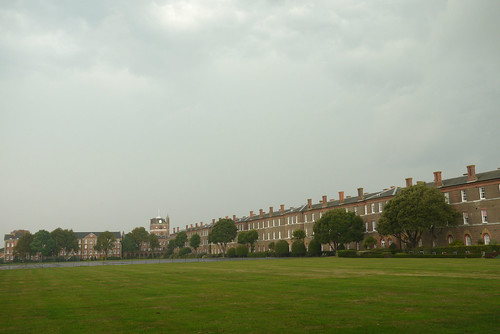
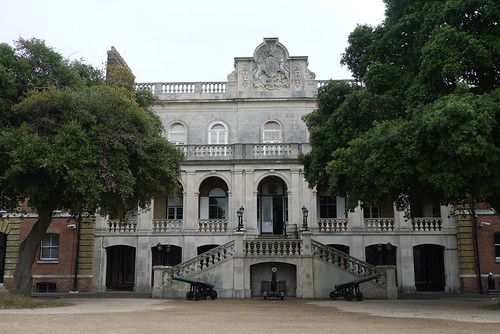
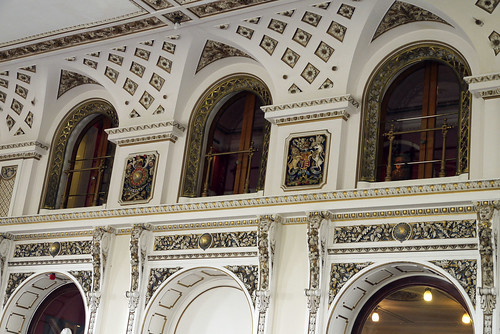
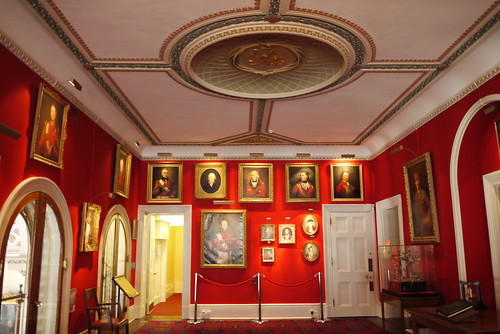
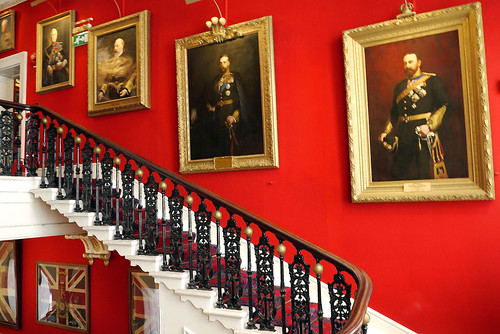
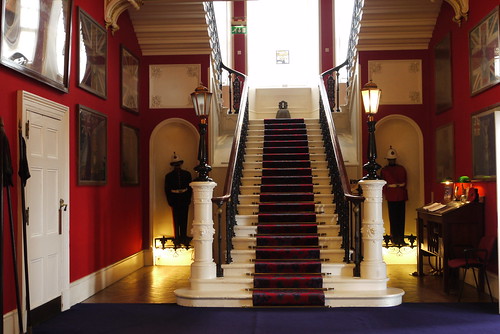








This is the new summer palace for Cherie, I presume.
I wish, it is a fabulous building
You will never believe this, Cherie – my Grandfather Love was stationed there, and was allowed to live “out” with his family as long as he was within the sound of the bugle call! He had been an artillery man for most if his time in the Royal Marines, but ended up as a Tailor for them when he was older. Both of my parents were brought up near here
What a wonderful family story I wished I had more time to explore around the outside of the building.
I wished I had more time to explore around the outside of the building.
As I was walking down the stairs taking photos I was trying to be discreet as I heard two gentlemen (ex marines) talking as the approached the the hall at the top of the stairs (about an event that they were attending in the Mountbatten room the next day). I paused on the landing to let them pass by. I felt they were rather uncomfortable with me being there so I smiled at them and said hello. They smiled and their eyes lit up as they returned they greeting
One needs to have experienced the atmosphere in an Officer’s Mess to get a full appreciation. The use of one (say, this one) as a museum that displays a history is a fitting tribute but what you describe of the ‘living’ Mess is an approach to the story.
I lived in several Messes. I also ‘lived-out’ as you say. The Mess living was fine indeed. Dining Nights, dining Offiers ‘In’, and ‘Out’ as newcomers arrived and other were posted off to other bases were ‘Parades’ You had to attend. Such dinners were sound excuses for finery and formality only to be followed by exceptionally riotous entertainment. the ‘Games’. ‘Tis best you do not know some of those goings-on.
The ‘library’ and other ante-rooms were centres of discussion, catching up on current affairs and study of military matters or quite recovery from a busy day, as was the ‘Bar’. In the RAF the Bar saw many hilarious escapades and the early starts to memorabilia. The positioning of a chap’s boots on the ceiling marked ‘ejections’ for instance (ejections from aircraft that is) and one I recall had a pair of high heels denoting a WRAF who had the experience of leaving an aircraft the faster than sound way.
At one base (North Luffenham) I was living in a wing of the Mess (my famlily was 150 miles distant and seen only at weekends) and the only other wing occupant in one of maybe 20 rooms was a very eminent man. I was a junior Officer, studying for my degree, part-time, at the time. My neighbour was a Group Captain, Professor, Doctor who ran the aeromedical school. An aging Scottish gentleman. Tom Whiteside. I could expect a midnight knock at my door and he would be there asking what I was studying and ever ready to offer ‘mentoring’. Excellent fellow. We would sit and ‘have a wee dram’ and he’d open a tall card-filing cabinet and take out at random some note he’d written during the day. It would have a thought or some point he’d read. “And what do you think about this?” he’d ask. By the Lord Harry he would make me think and articulate and argue properly !!
Being within the sound of the bugle changed over time. In my day it was the telephone. If you went on leave somewhere distant you had to leave telephone and address details so that you could be summoned back. Not that it nedded a real war to break out. Several times a year we would have ‘Taceval’, a practice war. Three or four days of mayhem when all our war-skills were put to the test. All the ‘living-out’ chaps were accomodated in the Mess, sharing those bedrooms with the permanent occupants. The bedrooms were not ‘en-suite’. Each wing had a toilet room and a laundry room. Gentlemen’s rules applied: “No snoring; no farting; no peeing in the sink’.
I recall one chap (at least one) who was on his holidays in the USA when got the call. He had to return home for Taceval. It was all over by the time he arrived.
The Mess. a Home full of memories and a sound place for a museum.
I enjoyed reading your personal anecdote, it brings the place to life. thank you I bet those walls could tell a fair few tales
I bet those walls could tell a fair few tales 
Many years ago one of my friends was married to an RAF officer. I remember attending an evening event in the mess, at which fancy dress was required. As the alcohol flowed the evening got rather lively LOL! Luckily the photographs of the occasion are temporarily in the garage
This Marines Museum is excellent and well worth a visit. It is one that I will go back to if I have the chance.
Perhaps I should add that I didn’t take the photos. They are photos of me plus others in fancy dress!
>the principle buildings were converted to residential use.
I don’t like this idea.
It’s best to use them as public buildings, say maybe art galleries, museums, open studios, restaurants. So more people get a chance to see what’s inside those buildings.
I expect the cost of keeping all those buildings open in that way is prohibitive. I am just glad they have preserved the buildings so from the outside they look as they were.
The museum building is fabulous
What a beautiful place and how wonderful that we can now see the interior – this is often lost when places are converted to residential use. I really love the rich interiors here, especially the exquisite detail in your third photo. Really beautiful.
Thank you, I am glad you like it
As I mentioned in comment above The Mountbatten room is still used for functions.
great shots, CP. every successive shot is even better!
Thanks Ayush
WE might be going to Plymouth for a couple of days soon. Any suggestions on places to visit, cherrypie?
Is it Plymouth or Portsmouth you are visiting?
If it is Plymouth I have not been near there for more years than I care to remember.
Very impressive. I never realised the extend of the barracks at Eastney. I do like the Officers’ Mess especially – very “them” and “us”
Them and us? What do you mean ‘us’?
You have to take a trip there with your camera
Sunday evening here. 7.30 pm and the Antiques Roadshow is from….. yes… this very Marine Museum.
What a co-incidence
Now you will probably have seen it in more detail
Impressive staircase and bold wall colour. Enjoyed your symmetry in the last one.
Although the last photo is not the best technically (the lighting), there is something about it that appeals to me too